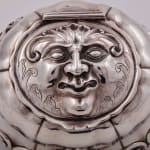Salt Cellar
City brand, tax mark, crown royal silver.
Chiseled and embossed.
Further images
This exquisite unique piece is one of the masterpieces of 18th-century Spanish-American art. Probably, if not necessarily, it is the result of a collaboration between Gregorio de Ávila Rincón and his children, mainly Francisco Xavier de Ávila Mérida. In the later work of the latter, the use of masks, applied or embossed, that sometimes wear a headband of feathers and others, as in this case, mythological elements such as pointed ears or horns, both from the classical iconography of the Satyrs.
The arrival of the Rococo to Guatemala was late - the first traces found are not prior to 1755 for domestic silverware - in which only after 1760, it quickly became the dominant style, completely replacing the “classicist baroque,” which had extended its presence in the workers of the capital since 1720.





